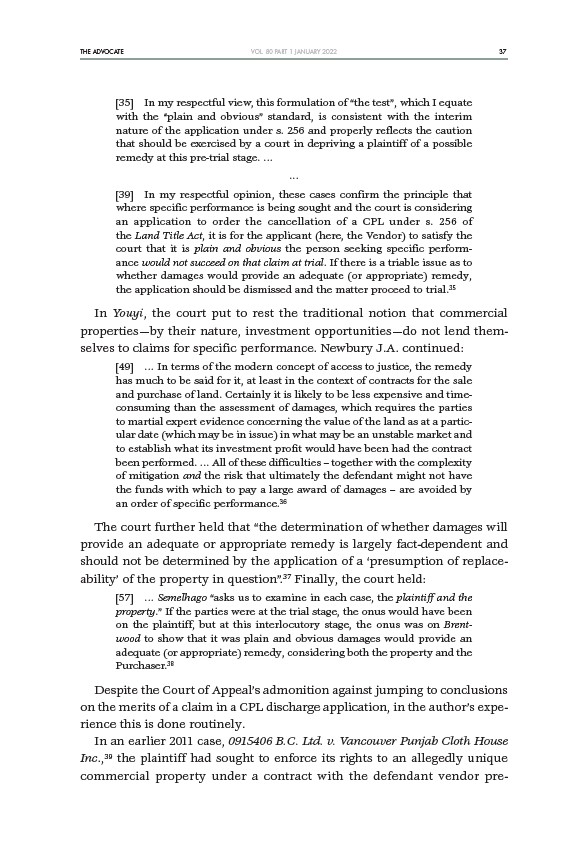
THE ADVOCATE 37
VOL. 80 PART 1 JANUARY 2022
35 In my respectful view, this formulation of “the test”, which I equate
with the “plain and obvious” standard, is consistent with the interim
nature of the application under s. 256 and properly reflects the caution
that should be exercised by a court in depriving a plaintiff of a possible
remedy at this pre-trial stage. …
…
39 In my respectful opinion, these cases confirm the principle that
where specific performance is being sought and the court is considering
an application to order the cancellation of a CPL under s. 256 of
the Land Title Act, it is for the applicant (here, the Vendor) to satisfy the
court that it is plain and obvious the person seeking specific performance
would not succeed on that claim at trial. If there is a triable issue as to
whether damages would provide an adequate (or appropriate) remedy,
the application should be dismissed and the matter proceed to trial.35
In Youyi, the court put to rest the traditional notion that commercial
properties—by their nature, investment opportunities—do not lend themselves
to claims for specific performance. Newbury J.A. continued:
49 … In terms of the modern concept of access to justice, the remedy
has much to be said for it, at least in the context of contracts for the sale
and purchase of land. Certainly it is likely to be less expensive and timeconsuming
than the assessment of damages, which requires the parties
to martial expert evidence concerning the value of the land as at a particular
date (which may be in issue) in what may be an unstable market and
to establish what its investment profit would have been had the contract
been performed. … All of these difficulties – together with the complexity
of mitigation and the risk that ultimately the defendant might not have
the funds with which to pay a large award of damages – are avoided by
an order of specific performance.36
The court further held that “the determination of whether damages will
provide an adequate or appropriate remedy is largely fact-dependent and
should not be determined by the application of a ‘presumption of replaceability’
of the property in question”.37 Finally, the court held:
57 … Semelhago “asks us to examine in each case, the plaintiff and the
property.” If the parties were at the trial stage, the onus would have been
on the plaintiff, but at this interlocutory stage, the onus was on Brentwood
to show that it was plain and obvious damages would provide an
adequate (or appropriate) remedy, considering both the property and the
Purchaser.38
Despite the Court of Appeal’s admonition against jumping to conclusions
on the merits of a claim in a CPL discharge application, in the author’s experience
this is done routinely.
In an earlier 2011 case, 0915406 B.C. Ltd. v. Vancouver Punjab Cloth House
Inc.,39 the plaintiff had sought to enforce its rights to an allegedly unique
commercial property under a contract with the defendant vendor pre-